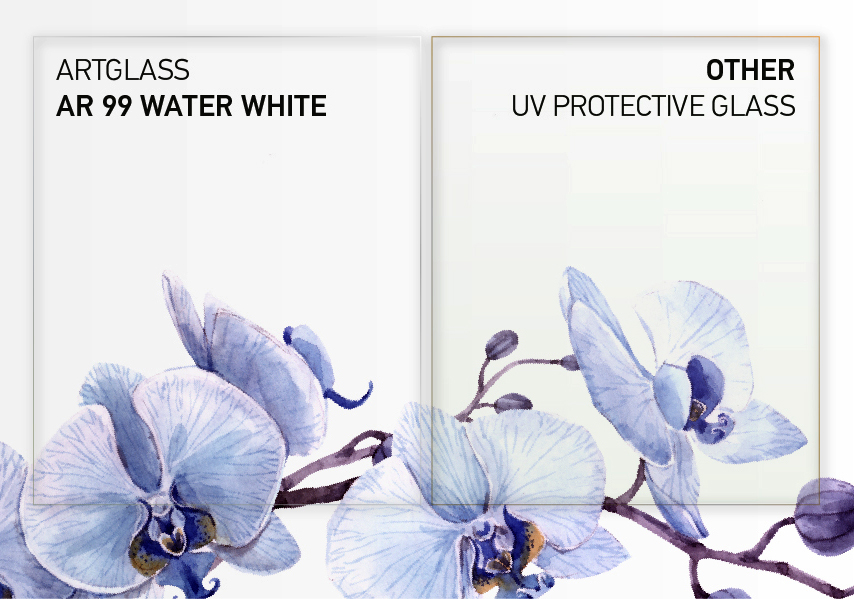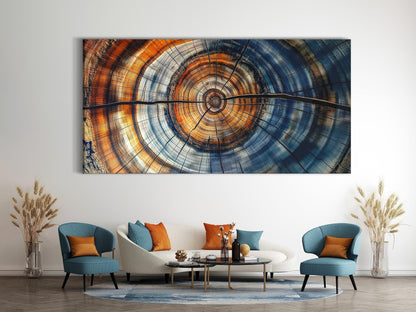The No‑Glare Wall: Museum Glass vs Acrylic vs Matte Paper, Compared
Lights on, reflections gone. Here’s how today’s anti‑reflective glazing and paper surfaces stack up—so your art stays front and center, not your ceiling fixtures.

Quick Compare — No‑Glare Options
| Surface | Reflections | Light Transmission | UV Protection | Weight & Safety | Best For | $ |
|---|---|---|---|---|---|---|
| Museum Glass® (AR‑coated, low‑iron) | ≈ <1% reflectance — “virtually invisible” look | ≈ >97% | up to 99% | Heavier, rigid; shatters if dropped | Frames up to medium‑large sizes, color‑critical work | $$$ |
| Optium Museum Acrylic® (AR‑coated acrylic) | ≈ <1.6% reflectance (double‑sided AR) | ≈ >98% | up to 99% | Lightweight, shatter‑resistant, anti‑static | Oversized pieces, high‑traffic spaces, traveling shows | $$$$ |
| Non‑glare Acrylic (matte/etched) | Matte diffuses reflections | Lower than clear/AR acrylic; can soften detail | Varies (often offered with UV‑filter versions) | Lightweight, shatter‑resistant | Harsh lighting, budget glare control; posters | $$ |
| Matte Fine‑Art Paper (no glazing) | No surface glare by design | Excellent diffuse viewing; slightly lower deep blacks vs gloss | Depends on inks/papers; no physical UV barrier | Lightest; no protective glazing | Canvas wraps, fine‑art prints hung out of direct sun | $–$$ |
Specs above summarize leading product families (Tru Vue® Museum Glass & Optium Museum Acrylic; Groglass Artglass AR 99 Water White). Actual performance varies by vendor and thickness.
Museum Glass®: the classic “invisible” pane
AR‑coated low‑iron glass minimizes reflections to under ~1% and pushes visible light transmission above ~97%, with UV protection up to 99%. You get crisp detail, neutral color, and the reassuring scratch‑resistance of glass. The trade‑offs: weight and shatter risk on big frames.
- Choose it when color fidelity matters (photography, works on paper) and sizes are modest to large, not monumental.
- Watch for weight on plaster walls and shipping risk for oversize pieces.
Optium Museum Acrylic®: glare control + safety for scale
Optium pairs double‑sided anti‑reflective coating with a hard, abrasion‑resistant layer and anti‑static properties—key for friable surfaces (charcoal, textiles) that attract dust. Reflectance stays below ~1.6% and transmission above ~98% while blocking up to 99% UV. Because it’s acrylic, it’s dramatically lighter and safer for large formats and public spaces.
- Choose it when you’re framing oversize work, installing in kids’ rooms or high‑traffic corridors, or traveling pieces.
- Watch for price premiums and the need to use non‑abrasive cleaning methods to protect the coatings.
Non‑glare Acrylic (matte/etched): diffusion that can blur
“Non‑glare” acrylic reduces reflections by texturing the surface so it diffuses light. It’s effective under harsh fixtures, but that diffusion can soften fine detail and reduce contrast—most noticeable over deep mats or highly detailed prints. It’s budget‑friendly and safer than glass, and UV‑filter versions exist, but AR‑coated acrylic usually looks sharper.
Matte Fine‑Art Paper: no glare from the start
Matte papers (think photo rag and smooth cottons) have a non‑reflective surface. If you print on canvas or matte paper and hang without glazing (or with a low‑gloss varnish), there’s virtually no surface glare. You’ll trade a touch of D‑max versus glossy stocks and you lose the physical barrier that glass/acrylic provides, so be mindful of sunlight, humidity and traffic.
Lighting still matters (a lot)
Even the best glazing can show a hotspot if a downlight aims straight at it. For framed art, start with the “30‑degree rule”: mount directional lights so the beam meets the wall at ~30°, which highlights texture while reducing viewer reflections. Modern high‑CRI LEDs eliminate UV and keep colors true; wall‑washing can evenly brighten a gallery wall with minimal glare.
When to choose what
Pick Museum Glass® if…
- You want the flattest, most neutral look on medium‑to‑large frames.
- The piece is stationary and weight isn’t a deal‑breaker.
- You prefer maximum scratch resistance from a glass surface.
Pick Optium Museum Acrylic® if…
- The art is oversized, travels, or hangs in busy spaces.
- You’re framing static‑sensitive surfaces (charcoal, textiles).
- You want shatter resistance plus anti‑static and AR coatings.
Pick Non‑glare Acrylic if…
- Harsh fixtures are unavoidable and budget is tight.
- The subject is bold and can tolerate a slight softening.
Pick Matte Paper/Canvas if…
- You want zero surface glare from the start.
- The piece hangs out of direct sun and doesn’t need a rigid barrier.
Care & cleaning
- AR glass: standard glass cleaners are typically fine; avoid abrasive pads.
- AR acrylic: use soft microfiber with light pressure; avoid solvents like acetone; follow the manufacturer’s tips sheets.
- Matte paper: dust gently; avoid touching print surfaces; consider a shadow‑gap frame or acrylic spacer if you later add glazing.
Further reading (great complements to this guide)
FAQ — People also ask
Is Museum Glass worth it compared with standard glass?
Yes if you care about color fidelity and seeing the art—not reflections. AR‑coated, low‑iron Museum Glass dramatically cuts reflections versus basic float glass, while adding UV protection for works on paper.
When should I spend on Optium Museum Acrylic instead of Museum Glass?
Go Optium for oversized pieces, public or kids’ spaces, or static‑sensitive surfaces. It’s lighter, shatter‑resistant and anti‑static, with anti‑reflective performance that stays very low.
Does non‑glare acrylic make art look dull?
It can. Matte‑etched acrylic diffuses reflections and image detail; bold subjects tolerate it better than fine linework. If you want sharpness and glare control, AR‑coated acrylic is the step up.
How do I reduce glare without changing my frames?
Aim lights ~30° to the wall, swap to high‑CRI LEDs, dim to the art, and avoid fixtures directly opposite windows. Wall‑washing a gallery wall also helps.
Is matte paper really “no‑glare”?
Yes—the surface itself isn’t glossy, so there’s no specular reflection. You’ll trade a bit of deep‑black punch vs glossy stocks and you won’t have a protective barrier unless you frame it.
References
- Museum Glass® — product overview (Tru Vue)
- Optium Museum Acrylic® — product overview + sizes (Tru Vue)
- Artglass AR 99 Water White — specs (Groglass)
- Anti‑glare vs Anti‑reflective — explainer (Tru Vue)
- Lighting art: aiming and glare basics (WAC)
- How to light artwork like a gallery (Lutron)
- LEDs in museums (Canadian Conservation Institute)
All trademarks belong to their respective owners. Product images used for editorial comparison and credited to sources above.











0 Kommentare